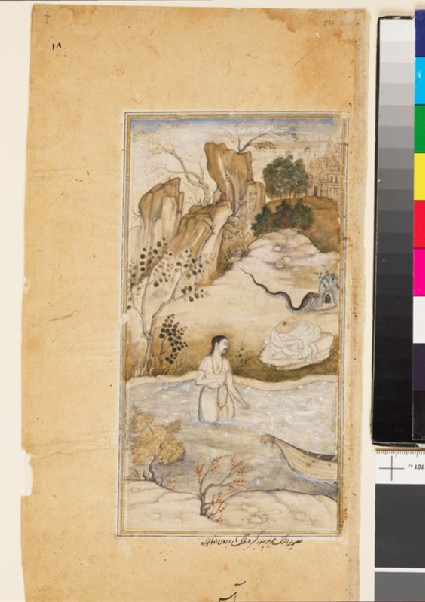Search Results: objects
Show search help- Reference URL
Actions
The sage Uttanka in a river while the snake king steals the earrings
-
Description
To promote Muslim-Hindu understanding, Akbar ordered the Mahabharata epic and other classic Hindu texts to be translated into Persian, the court language. This manuscript may have been commissioned by his minister ‘Abd ur-Rahim Khankhanan.
-
Details
- Associated place
-
Asia › India › north India (place of creation)
- Date
-
1598
Mughal Period (1526 - 1858)
- Artist/maker
-
Asi (active late 16th century) (artist)
- Associated people
-
probably 'Abd ur-Rahim Khankhanan (1556 - 1626) (commissioner)
- Material and technique
- gouache on paper
- Dimensions
-
mount 40.3 x 27.6 cm (height x width)
page 29.7 x 16 cm (height x width)
painting with border 20.2 x 10.8 cm (height x width)
painting without border 19.6 x 10 cm (height x width)
- Material index
- Technique index
- Object type index
- No. of items
- 1
- Credit line
- Gift of Gerald Reitlinger, 1978.
- Accession no.
- EA1978.2591
-
Further reading
Harle, J. C., and Andrew Topsfield, Indian Art in the Ashmolean Museum (Oxford: Ashmolean Museum, 1987), no. 83 on p. 76, p. xiv, illus. p. 76
Location
-
-
First floor | Room 33 | Mughal India

-
First floor | Room 33 | Mughal India
Objects are sometimes moved to a different location. Our object location data is usually updated on a monthly basis. Contact the Jameel Study Centre if you are planning to visit the museum to see a particular object on display, or would like to arrange an appointment to see an object in our reserve collections.
Publications online
-

Indian Art in the Ashmolean Museum
As part of his plan to promote understanding between his Muslim and Hindu subjects. Akbar ordered that several Hindu texts, including the Mahābhārata and the Rāmāyaṇa, should be made available in Persian translation. Magnificent illustrated copies of each of the two epics were made for the imperial library and these are now in the Jaipur royal collection. Less splendid versions were copied and illustrated for the Mughal nobility, though few examples now survive. It has been suggested that the patron of the 1598 Razm-nāma manuscript could have been ‘Abd ur-Rahīm Khānkhānan. Akbar’s leading minister and a famous bibliophile who employed his own artists. However it is more likely that the manuscript, though not of full imperial quality and possibly destined for a nobleman’s library, was in fact produced in Akbar’s studio by younger apprentice artists many of them the sons of established painters.
The scene illustrated here is an early episode from the first book of the Mahābhārata, in which, while the young sage Uttanka is fetching water, the snake-king Tasaka steals the earrings which have been given to Uttanka by Pausya’s queen. It is painted in the mature Akbari style, a synthesis of Persian, Indian and (especially in the landscape) European elements, but the colouring, with dominant grey and khaki tones is untypically muted. Āsa (or Āsi), son of Maheṣa, painted nine pages of this Razm-nāma and is known to have worked on several other manuscripts of the period.
The manuscript was largely dispersed at auction in 1921. Five other pages are in the Museum’s collection, also the gift of Gerald Reitlinger.
© 2013 University of Oxford - Ashmolean Museum






